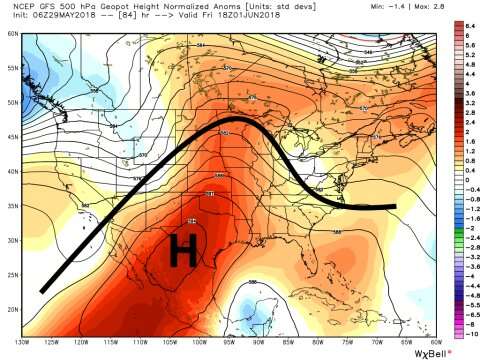This article has been reviewed according to Science X's editorial process and policies. Editors have highlighted the following attributes while ensuring the content's credibility:
fact-checked
peer-reviewed publication
proofread
Research links climate change to 'lazier' jet stream, leading to extreme weather

Jet streams are relatively narrow bands of strong wind in the upper atmosphere, typically occurring around 30,000 feet, and blowing west to east. Their normal flows lead to week-to-week weather variations, modulated in the mid-latitudes by ridges and troughs in the jet stream. A high-pressure ridge, for example, produces clear, warmer weather conditions; a trough is typically followed by stormy conditions. Together, these form waves in the jet stream that can stall as the waves grow and become more amplified, causing "stuck" weather patterns that produce longer storms and heat waves.
New research published in Nature Communications describes observations linking increased warming at high latitudes and the ever-decreasing snow cover in North America to these stalls in atmospheric circulation.
"These persistent and extreme conditions are thought to be increasing in the future as a result of this increased waviness in the jet stream," said the study's lead author Jonathon Preece, a postdoctoral researcher at the University of Georgia.
Since 2000, frequent "stuck" weather patterns have produced heat waves over Greenland, resulting in exceptional melting of the Greenland Ice Sheet. In contrast to these observations, global climate models actually project a slight decrease in the blocked patterns over Greenland and, consequently, the models have underrepresented the contribution of meltwater runoff from the ice sheet to global sea level rise.
"These patterns have been consistently creating pulses of melting over the Greenland ice sheet that have been accounting for a large portion of the annual melting," said study co-author Marco Tedesco, a professor at Columbia Climate School's Lamont-Doherty Earth Observatory, and lead principal investigator on the project. "Accounting for such an aspect is crucial for anticipating not only how much but how fast Greenland is and will be contributing to sea level rise."
"One question is whether this is a consequence of climate change that we can expect to continue in the future [that] the climate models are failing to resolve," said Preece. "Or are the climate models correct, in which case we'd expect things to revert back to the norm and perhaps the rate of accelerated melt of the ice sheet will taper some?"
The new study presents evidence of a link to climate change, both in the increases in jet-stream waviness and ever-decreasing spring North American snow cover extent, which "is impacting the atmosphere in a way that is favoring these blocked high-pressure systems over Greenland," Preece said.
Multiple studies have highlighted the discrepancy between climate models and observations. This study provides evidence of a direct connection between the observed shift in summer atmospheric circulation over Greenland and amplified warming at high latitudes.
"The new study is the first that we know of that demonstrates a direct link between the observed change in summer atmospheric circulation over Greenland and diminished spring snow cover, which is something we can confidently say is a consequence of climate change," said co-author Thomas Mote, a geographer at the University of Georgia.
More information: Jonathon R. Preece et al, Summer atmospheric circulation over Greenland in response to Arctic amplification and diminished spring snow cover, Nature Communications (2023). DOI: 10.1038/s41467-023-39466-6
Journal information: Nature Communications
Provided by Earth Institute at Columbia University
This story is republished courtesy of Earth Institute, Columbia University http://blogs.ei.columbia.edu.




















